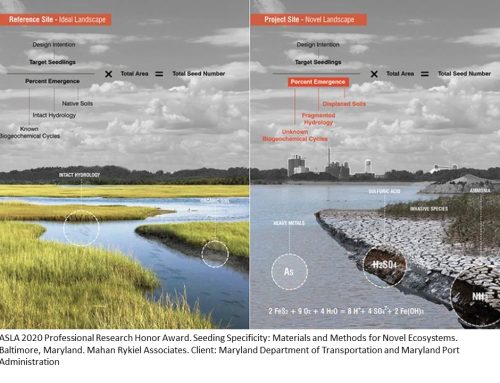Not just for Plant Establishment anymore, but also for Erosion Control, Storm Water Management and Green Infrastructure
by Ron Alexander
The use of recycled organics is one of our nation's greatest assets, and we can utilize them to address several of societies vexing challenges. The commercialization of composting as an economic method to manage organic (carbon-based) 'wastes', got its rebirth in the late 1970's and has grown from coast to coast; with over 4,500 larger-scale facilities in operation and over 100 licensed facilities in California. These facilities manufacture a unique soil amending product , 'compost' – which can be used in a multitude of applications (figure 1), which provide many benefits (figure 2). Over the past 35 years +, compost has become a staple of the landscaping industry and a 'fan favorite' of home gardeners. Of course, compost is also popular in many other applications; including turf establishment and maintenance, and agricultural production. Compost has the ability to improve the physical, chemical and biological characteristics of soil, creating “Healthy Soils”. Healthy Soils have a more symbiotic relationship with plants, and they assist plant health and sustainability by:
• Reducing soil compaction in heavy soils,
• Improving moisture holding capacity and availability,
• Providing some nutrients (for both the plants and the soil microbes), and
• Supplying stabilized carbon, which is food for soil microbes.
Some of these microbes work symbiotically with plant roots, helping them better absorb nutrients and water, while others offer natural disease suppression. But there's much more to the story, as compost can be used in more sustainable or ‘green’ construction practices, and in soil and water management techniques that are often less expensive and more effective than current techniques. Understanding these facts, the State of California has created a Healthy Soils Initiative which will begin being implemented in 2017.
The Food and Agriculture Organization of the United Nations defines “Soil health” the capacity of soil to function as a living system. Healthy soils maintain a diverse community of soil organisms that help to control plant disease, insect and weed pests, form beneficial symbiotic associations with plant roots, recycle essential plant nutrients, improve soil structure with positive effects for soil water and nutrient holding capacity, and ultimately improve crop production. A healthy soil also contributes to mitigating climate change by maintaining or increasing its carbon content.
California is the nation's leading agricultural production state in terms of both value and crop diversity (http://www.cdfa.ca.gov/Statistics/). California's Healthy Soils Initiative is a collaboration of state agencies and departments, led by the California Department of Food and Agriculture (CDFA), to promote the development of healthy soils on California's farm and ranchlands. Innovative farm and ranch management practices contribute to building adequate soil organic matter that can increase carbon sequestration and reduce overall greenhouse gas emissions.
Following this introductory article, we will provide articles outlining the use of compost in common landscaping practices, then erosion control and storm water management, and 'low impact development (LID) and green infrastructure type applications (e.g., component to green roof, bioretention, bioswale media, etc.). Effectively specifying and purchasing compost will also be discussed. It should be mentioned that compost is required in the creation of Water Efficient Landscapes (current statewide ordinance) and in many bioretention soil mixes used throughout Northern California.
Interestingly, aside from helping plants establish and grow, all of the applications mentioned above provide important environmental benefits related to water and soil protection and conservation, and storm water management. The importance of mentioning these technical benefits is that with a changing climate, the general public will end up incurring greater costs related to managing the effects of both more frequent and severe droughts, as well as rain storm events (e.g., flooding). Aside from on-going drought conditions that have been experienced in California, which exacerbate the spreading of wild fires (and post-fire conditions that lead to mud slides) many communities have also had to deal with the cost of managing ever growing volumes of storm water. Although we are we aren't suggesting that the use of compost in the applications outlined above will mitigate the effects of these devastating events and inadequate infrastructure, we can surely prove that we can lessen their effects, and do so in an economic fashion , while adding more carbon to the soil, slowing the effects of climate change. Further, it illustrates the importance of developing dual purpose landscapes, ones which are both attractive and provide environmental functionality, and the importance of the landscape industry to provide these new services and ‘products’.
Mr. Alexander has over 30 years of experience working with compost and other organic recycled products on large-scale construction projects. He is also the President of R. Alexander Associates, Inc., a consulting company specializing in
product development for organic recycled products. He is the author of the 'Field Guide to Compost Use', American Association of State Highway and Transportation Officials’ Erosion Control Specifications for Compost, and ‘Landscape
Architecture Specifications for Compost Utilization’. He is funded in California by the City of San Jose, Republic Services and Zanker Road Resource Management, Ltd. Contact Ron Alexander at alexassoc@earthlink.net or 919-367-8350 if you are interested in a compost Lunch & Learn.
Figure 1 , Compost Applications
Soil Incorporation
Turf establishment
Garden bed preparation
Reclamation/remediation
Nursery production
Roadside Vegetation
Surface Applied
Garden bed mulch
Erosion control media
Turf topdressing
Growing Media Component
Container/potting substrates
Landscape (e.g. rooftop, raised planters)
Backfill mixes (tree and shrub plantings)
Golf course (e.g. tee, green, divot mixes)
Manufactured topsoil
Storm water management (e.g., bioretention, rain garden, rooftop garden, bioswales)
Figure 2 , Compost Benefits
• Improves soil structure and porosity , creating a better plant root environment;
• Increases moisture infiltration and permeability, and reduces bulk density of heavy soils , improving
water infiltration rates and reducing erosion and runoff;
• Improves the moisture holding capacity of light soils , reducing water loss and nutrient leaching, and
improving moisture retention;
• Improves the cation exchange capacity (CEC) of soils;
• Supplies organic matter;
• Aids the proliferation of soil microorganisms;
• Supplies beneficial microorganisms to soils and growing media;
• Encourages vigorous root growth;
• Allows plants to more effectively utilize nutrients, while reducing nutrient loss by leaching;
• Enables soils to retain nutrients longer;
• Contains humus , assisting in soil aggregation and making nutrients more available for plant uptake;
• Buffers soil pH;
• Supplies essential plant nutrients.
Developed by R. Alexander Associates, Inc. for the US Composting Council





